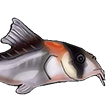Jungwirth, A, JN Kern, M Siddiqui, A Chiang, N Eisen, E Lac, G Wilkinson & RJ Riley, 2025. Nuanced effects of relative body size on social motivation in a highly gregarious catfish. Behavioural Processes doi: 10.1016/j.beproc.2025.105218.
Abstract
Many factors affect the social strategies that individuals adopt, including environmental parameters, developmental stage, and familiarity, but these are typically investigated in isolation. Understanding how social strategies are shaped by various potentially interacting factors is fundamental to understanding social evolution. We used highly gregarious catfish from the subfamily Corydoradinae to assess how familiarity, environmental cues, and relative body size impact coordination and communication within pairs of fish. Unlike many other model systems, Corydoradinae catfish exhibit clear inter-individual social overtures (termed ‘nudges’) that serve as an easily quantifiable measure of social motivation. Our results show that relative size was a significant predictor of individual nudges across all factor combinations, with smaller individuals nudging at higher rates than their larger partner. However, this effect was most pronounced among socially unfamiliar individuals that shared an environmental background (i.e. diet), but was largely absent when fish were familiar with one another or came from different environmental backgrounds. Cories thus appear to differ from the common behavioral model system three-spined sticklebacks in that familiarity and shared environmental background do not have the same effect on social preferences. Together these results demonstrate that relative body size is important in social interactions of these fish, but that other factors alter its impact. We thus show that individual characteristics affect social motivation in complex ways that likely influence group coordination and composition. This may explain the persistence of the highly heterogeneous groups these fish form in the wild.
Smaller corys nudge more
- Silurus
- Posts: 12475
- Joined: 31 Dec 2002, 11:35
- I've donated: $12.00!
- My articles: 55
- My images: 902
- My catfish: 1
- My cats species list: 90 (i:0, k:0)
- Spotted: 432
- Location 1: Singapore
- Location 2: Moderator Emeritus





